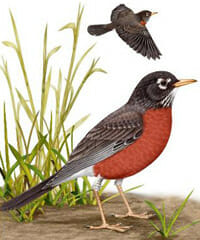North America Robin – Passeriformes Turdidae Turdus migratorius
 |
 |
 |
 |
Identification & Description:
• Large thrush.
• Back and wings gray.
• Underparts red.
• Dark head with white eye crescents.
• Throat white with black streaks.
• Lower belly and under tail white.
• Gray tail moderately long with white spots at corners of outer tail feathers.
• Bill yellow.
• Occasionally show pale eyestripes on pale individuals.
• Size: 20-28 cm (8-11 in)
• Wingspan: 31-40 cm (12-16 in)
• Weight: 77 g (2.72 ounces)
Facts
• Hundreds of thousands of American Robins can gather in a single winter roost. In summer, females sleep on the nests and males congregate in roosts. As young robins become independent, they join the males in the roost. Female adults go to the roosts only after they have finished nesting.
• The American Robin eats both fruit and invertebrates. Earthworms are important during the breeding season, but fruit is the main diet during winter. Robins eat different types of food depending on the time of day; they eat earthworms early in the day and more fruit later in the day. Because the robin forages largely on lawns, it is vulnerable to pesticide poisoning and can be an important indicator of chemical pollution.
• An American Robin can produce three successful broods in one year. On average, though, only 40 percent of nests successfully produce young. Only 25 percent of those fledged young survive to November. From that point on, about half of the robins alive in any year will make it to the next. Despite the fact that a lucky robin can live to be 14 years old, the entire population turns over on average every six years.
• Although the appearance of a robin is considered a harbinger of spring, the American Robin actually spends the winter in much of its breeding range. However, because they spend less time in yards and congregate in large flocks during winter, you’re much less likely to see them. The number of robins present in the northern parts of the range varies each year with the local conditions.
Other Names
Merle d’Amérique (French)
Mirlo primavera (Spanish)
Immature
Juvenile looks somewhat similar to adult, but has black spotting on underparts, pale spotting on upperparts, white throat, and paler head.
The American Robin is a familiar sight pulling up worms on suburban lawns. Although it’s at home breeding in deep, mature forests, the robin is the most widespread thrush in North American thanks to a tolerance for human-modified habitats.
Range
Summer Range
Breeds throughout most of North America, from Alaska and northern Canada southward to northern Florida and Mexico.
Winter Range
Winters mostly south of Canada to Florida and Gulf Coast, to central Mexico. Winters along Pacific Coast to southern Alaska.
Habitat
• Found in forests, woodlands, and gardens, especially where short-grass areas are interspersed with shrubs and trees.
• Common in urban and suburban areas.
Food
Invertebrates, especially earthworms, and fruit.
Behavior
Foraging
Forages primarily on the ground for soft-bodied invertebrates. Finds worms by sight, then pounces on them and pulls them up.
Reproduction
Nest Type
An open cup of grass and twigs held together with a thick layer of mud. Lined with fine dry grass. Nest is usually relatively low in a tree on a firm branch with dense foliage, but can be placed from ground to treetop.
Egg Description
Robin’s egg blue.
Clutch Size
Usually 3-4 eggs. Range: 2-5.
Condition at Hatching
Helpless with some sparse down.
North American robins belong to the family Turdidae of the order Passeriformes. They are sometimes placed in the family Muscicapidae. The European robin is classified as Erithacus rubecula. The American robin is classified as Turdus migratorius.
Robin, name first given to a small bird of the thrush family, familiar in England from living in close proximity to humans. The name was later applied by settlers in other parts of the world to birds of somewhat similar appearance—in North America to another species of the thrush and to members of several endemic genera of songbirds of Australia and New Guinea.
The American robin, a true thrush, is one of the largest and most numerous of American thrushes, with a body about 25 cm (about 10 in) long. The male is olive-gray; the top and sides of the head are black, the chin and throat are white with black streaks, and the breast and underparts are reddish orange. The female is of duller hues. The bird, like its European namesake, migrates and lives close to human dwellings. Its nest is built of coarse grass and reeds, plastered inside with mud and lined with grasses. The eggs, laid in a clutch of four to five, are a uniform greenish blue.